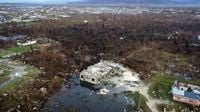As delegates from around the globe gathered in Belém, Brazil, for the COP30 climate summit on November 11, 2025, the urgency of climate adaptation took center stage. With typhoons battering Southeast Asia and communities in Jamaica and Brazil still reeling from recent storms, the summit’s focus was clear: how can the world’s most vulnerable nations withstand the mounting barrage of extreme weather?
Adaptation, a term once relegated to the sidelines of international climate negotiations, has now become a rallying cry. According to a United Nations report from October 2025, developing countries will require up to $310 billion annually by 2035 just to prepare for the escalating threats posed by climate change. Where will this staggering sum come from? That question loomed large over the COP30 proceedings, as leaders and experts grappled with both the scale of the need and the challenge of funding it.
“Lives, well-being and jobs cannot be sustained where homes, schools, farms and businesses are under threat from flooding, drought, or other climate extremes,” declared a joint statement from ten of the world’s largest development banks on November 10, as reported by Reuters. These banks, under increasing pressure to mobilize more resources for climate action, pledged to continue their support. Last year alone, they channeled more than $26 billion to low- and middle-income economies for adaptation projects, a figure that—while significant—still falls far short of the estimated need.
But the financial picture is not entirely bleak. Markus Repnik, director of the multipartner UN Systematic Observations Financing Facility, announced plans for a new $200 million impact bond aimed at raising funds for climate adaptation by the end of 2026. “The whole bond idea started exactly one year ago at the previous COP in Baku,” Repnik told Reuters. “We were getting the sense that things are going to change significantly from an international perspective.” The fund, backed by the World Meteorological Organization, UN Development Programme, and UN Environment Fund, also works to address critical gaps in weather data for developing countries—an often overlooked but vital part of climate resilience.
Meanwhile, Germany and Spain stepped up with a $100 million pledge to the multilateral Climate Investment Funds (CIF) on November 10, 2025. These funds are earmarked for projects that boost climate resilience in developing nations. Tariye Gbadegesin, CIF’s Chief Executive, praised Brazil for putting adaptation front and center at COP30. “We’re really thrilled that, for the first time, adaptation is Day 1 and Day 2 of the COP,” Gbadegesin told Reuters, highlighting a shift in priorities after years of adaptation issues being overshadowed at UN climate summits.
For many countries, the need for adaptation is not abstract—it’s immediate and devastatingly concrete. Vietnam, for example, estimated nearly $300 million in damages from Typhoon Kalmaegi in October 2025, just a month after Typhoon Bualoi inflicted $436 million in property damages. The Philippines, still tallying the costs from Kalmaegi, was struck again in early November by the deadly Super Typhoon Fung-wong, leaving entire communities flooded and infrastructure in ruins. According to Rappler, Jamaica faces up to $7 billion in damages from Hurricane Melissa, a figure that represents about a third of the nation’s GDP—an almost unimaginable blow for a small island country.
And it’s not just storms. Flooding, extreme heat, drought, and wildfires are all exacting a heavy toll. At COP30, delegates discussed a range of adaptation efforts, from funding air conditioners and fans for those suffering under extreme heat waves, to deploying artificial intelligence to map soil conditions and improve crop yields. The goal: find innovative, scalable solutions that can help communities weather the literal and figurative storms ahead.
Yet, even as public funds are marshaled, attracting private investment remains a major hurdle. As noted in a September report by the Zurich Climate Resilience Alliance, public funding is still the backbone of adaptation finance. Private finance, currently making up just 3% of adaptation funding, could rise to 15% with the right policies, but resilience projects often lack the profit potential of renewable energy ventures. “We need resources that flow directly to local partners and communities who are already leading the response—rebuilding homes, restoring livelihoods, and protecting health systems from climate shocks,” said David Nicholson, chief climate officer at Mercy Corps, a member of the Alliance, as reported by Rappler.
The human cost of climate disasters extends beyond property damage and economic loss. According to a UNHCR report released during the summit, about 86 million refugees—three-quarters of the world’s population displaced by conflict—are also exposed to extreme climate hazards. For these individuals, adaptation measures are not just about resilience; they’re about survival.
UN climate chief Simon Stiell emphasized the importance of tracking progress in adaptation efforts. “We now need to agree on the indicators that will help speed up implementation, to unleash its potential,” he said, urging countries to develop concrete ways to monitor and accelerate change in critical areas like water, sanitation, and health.
Despite the daunting challenges, there were glimmers of hope at COP30. More adaptation initiatives are expected to be announced, and the summit’s early focus on resilience has already set a new tone for international climate cooperation. For many, the acknowledgment that adaptation is as crucial as mitigation signals a long-overdue shift in the global conversation.
Still, the road ahead is long and uncertain. As storms grow fiercer and their aftermath more costly, the world’s most vulnerable populations remain on the front lines. Without sustained financial support and innovative approaches, the gap between need and action may only widen.
The COP30 summit, then, stands as both a warning and a call to action—a reminder that adaptation is no longer a distant goal, but an urgent necessity for millions worldwide. As delegates pack up and the world’s attention shifts, the true test will be whether the promises and pledges made in Belém translate into real, lasting change for those who need it most.




